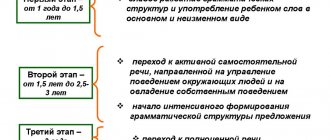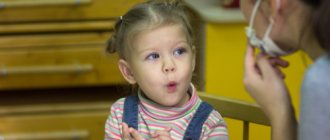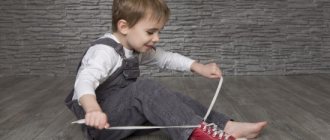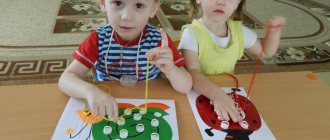Having passed the 3-year mark, children continue to develop rapidly. This progress is especially noticeable in their speech: their vocabulary grows, pronunciation, intonation, expressiveness improve, verbal structures become more complex, monologues become more coherent and consistent. At this stage, it is necessary to properly help the kids in their progress. To do this, it is important to know the main characteristics of the speech development of your children at the age of 4–5 years and understand what is important to work on now.
Age features
After 4 years, children are able to fluently use adverbs, adjectives, and prepositions, although the purity of pronunciation may still suffer due to difficulties with sonorants or sibilants (however, by the end of the fifth year, all sounds normally fall into place). A huge role in this belongs to parents, their ability to create a correct, active speech environment around the child and a favorable environment in the family.
The speech of children of primary preschool age is characterized by the following features:
- children can name the names, patronymics, surnames of all members of their family, and residential address;
- speak 3000–4000 words and actively use them;
- know how to navigate the time of day and the space around them;
- know the names and sequence of seasons;
- know all the basic geometric shapes, counting to five;
- use polite words;
- can identify their well-being and mood;
- know how to fully answer questions and ask them to the interlocutor;
- make a fairly detailed retelling, compose stories on a given topic, come up with the end of the designated story;
- can describe objects, identify an object only by description;
- build phrases of 6–8 words;
- use the imperative mood, plural;
- use synonyms and antonyms,
- use adjectives, adverbs, prepositions correctly;
- coordinate words in a sentence by gender, number, case;
- determine the distinctive features of objects;
- know different professions and their essence;
- can easily retell what they heard and saw;
- They know poems, tongue twisters, and funny nursery rhymes by heart.
At this age, do not put pressure on your child, forcing him to speak correctly and clearly - you will achieve the opposite effect. It is better to make comments in a soft form, affectionately, and friendly. Then the child will probably correct his mistakes very quickly.
What will we develop?
For children 4–5 years old, several aspects of speech development are important, which directly depend on the level of their general development and condition, as well as the speech skills they have achieved.
- Active dictionary.
Now, in addition to nouns and verbs, the speech of preschoolers is distinguished by the presence of adverbs with signs of time and space (soon, now, about, around). The concept of stages of generalization (mouse - rodent - animal) appears. Children know animals, their babies, parts of objects (a car wheel, a cabinet shelf, a chair leg).
Expanding your vocabulary at this age is the main rule for mastering coherent speech.
- The grammatical structure of speech.
Children of this age are actively engaged in word formation. They begin to use suffixes that designate a person by his profession. Now the child forms word forms in a similar pattern, using the same grammatical features. Sometimes it may turn out incorrectly: it hurts - more painful, louder - louder. In the speech of children, there are fewer and fewer errors associated with the inflection of nouns and verbs. But if a mistake is made, after a hint from an adult, the child quickly learns the correct option: floor - floors, lake - “lakes” - lakes.
Mastering the grammatical construction of sentences will help children speak correctly, avoiding speech errors.
- Coherent speech.
After 4 years, children develop contextual speech in addition to situational speech. Inconsistent presentation of events and retelling with the help of questions or prompts from adults are also possible. By the age of 5, without additional help, a child can compose a coherent retelling of several dozen sentences, and among them there are already complex and complex constructions. At this age, the internal, planning function of speech is formed - it becomes a means of planning and regulating the child’s internal behavior.
From this time on, the speech gradually turns into a full-fledged story. In addition, the child increasingly uses the communicative function of speech - uses it for a variety of communication with others. He can ask again, object, clarify, and answer questions with reason.
Mastering coherent speech is an important factor in the success of a child’s further education.
- Speech (phonemic) hearing.
Children of this age group distinguish sounds of different articulations (for example, [a] and [r]), and note pronunciation errors not only in those around them, but also in themselves. Change intonation and timbre of voice during expressive retelling. They can distinguish vowels from consonants, hard from soft, hissing from whistling. They are able not only to determine whether there is a specific sound in a word, but also where exactly it is located (at the beginning, middle, end of the word).
The development of phonemic awareness allows you to pronounce words correctly, and then reproduce them in writing just as correctly.
- Pronunciation.
Normally, by the end of the 5th year, all inaccuracies and difficulties in sound production should disappear in a preschooler. Perhaps the child will pronounce middle sounds between [s] and [sh], [z] and [z], if he has recently mastered them. Sometimes children at this age do not pronounce [r]. At 5 years old, this problem already requires correction by a speech therapist.
So, a five-year-old child should speak expressively, coherently, using a rich vocabulary and a variety of syntactic structures, with virtually no speech errors, pronouncing all sounds clearly. It is important to work on this by involving the child in various linguistic games.
Speech development tasks for children 4-5 years old
Below are several options for such tasks.
“Which word is extra and why?”
The goal of the game is to develop auditory attention, auditory memory, and logical thinking. The game will also help automate your speaking skill. In some cases it is used to treat stuttering. In this case, a hand is added for smoother speech.
The speech therapist says four words. The child repeats them and says which word is extra. He then explains why he chose that particular word.
For example: chair, table, sofa, tree. The extra word is tree, because everything else is called furniture, and tree is a plant.
Speech development tasks for children 4-5 years old
“Say it differently (learn synonyms)”
This is a ball game. It develops memory, speed of thinking, and logic. The teacher calls the word and throws the ball to the child. The kid must catch and come up with a synonym word. The words could be:
- Skyscraper),
- Protect (nature)
- Drive,
- Famous (person).
The words themselves are best pronounced in phrases. This way the child will be able to better understand the meaning of the word.
There is a second option. In it you need to name the antonym of the word you hear.
In general, this game can be modified in different ways. For example, the teacher may not say anything to this child. The child can see or hear some object, make a guess about it and name its synonym or antonym - it depends on the specific task.
"I'll start talking, and you finish"
This game can also have many variations: add letters or syllables to make words, or you can invent words to make a sentence. The main skill that this game develops is to think logically. For example:
- “In summer the grass is green, and in autumn……(yellow).”
- “The road is wide, but the path…..(narrow).”
The teacher asks questions and the children answer them
To develop speech, you need to communicate. But in conditions where parents are constantly working, this is often difficult to do. A kindergarten (preschool) helps with this. Teachers interact with children and teach them how to communicate with others. But how to provoke them to talk? Communication workshops can help. This can also be done using questions.
Educator
But here there are several rules:
- The easiest way to communicate is on the topic of what is happening around. For example, if your baby is playing with toys, you can ask him what color, size, shape, etc. they are.
- Questions should be clear, specific and concise. The child's psyche simply does not perceive questions that are too long. Attention instantly switches to something more interesting and understandable.
- It is better to stick to one topic when asking questions. For example, if a teacher asks about one toy and then moves on to a question about parents, the child may simply misunderstand him. If we have already started talking about toys, the topic needs to be continued.
Children's speech is not yet clear enough. Its development is certainly very important. And you shouldn’t neglect them, even if it seems that everything is fine with the child. The better a preschooler’s ability to communicate is developed, the better the processes of adaptation and socialization at school will be. This task falls on the shoulders of educators.
How to properly give speech therapy massage to a child at home
With the help of family
Growing up in a family, a child, first of all, adopts the experience of communicating with relatives: their vocabulary, ways of constructing sentences and expressing thoughts, intonation. Therefore, the speech development of children always depends on the environment in which they find themselves. How active and correct she is in terms of speech makes her psychologically comfortable.
The following tips will help you avoid mistakes.
- Do not imitate your baby's speech if it is incorrect: do not lisp, do not distort words or sounds.
- Always speak clearly and correctly, use the right emotions and intonations, the right tempo and strength of voice.
- When communicating with a child, try to exclude difficult to pronounce words, complex or incomprehensible phrases and expressions from your speech. It is important to explain unfamiliar words found in the work to a preschooler at a level accessible to him, reinforce them with examples, and try them out in practice.
- When asking a child about something, ask clear, specific questions, give them time to understand them, and don’t push them with an answer.
- Don’t imitate or get irritated if your baby makes a mistake: correct it calmly, gently.
- Read more poetry - it helps to master the rhythm of speech;
- Try to avoid frequent quarrels, scandals, cruel punishments, threats, and blackmail. All this not only inhibits the development of speech, but can lead to more serious consequences: stuttering, isolation, embitterment of the child, the appearance of complexes and phobias.
Game "Who eats what"
These are simple games. The first game is based on the child's knowledge of the nutrition of domestic and wild animals.
At the initial stage the following pairs are used
- The cow eats grass.
- The goat eats grass.
- The horse eats grass.
- The sheep eats grass.
- The cat eats meat and fish.
- The dog chews on a bone.
- The bear eats honey.
- The hare eats a carrot (for children of a good level it is better to say that the hare eats grass, twigs and tree bark)
- The fox eats the hare.
- The mouse eats cheese.
Puzzle games and counting sticks are used.
If the child is good at “distributing” food to animals, you can play the game in reverse.
A child or an adult builds houses; we place food near each house (can be cut out of paper, molded from plasticine, etc.). The child needs to guess who lives in this house. If the animals are wild, then “lay out” food in the forest - make a forest out of the same sticks.
We teach in the game
After analyzing the above norms, parents can understand which areas of their child’s speech need to be developed first: those with which there are problems. To correct each individual area, you can select appropriate games for speech development. First of all, to expand your vocabulary. Here are some examples of such games.
- The adult names the object, and the child must put this word in the plural (wall - walls). In the course of such a game, you can also touch on polysemy (for example, a child, a chair or a seat can have a back, and a mug in the plural, only with a different emphasis - these are both geometric figures and sections for creative activities). At the same time, the child’s attention is promptly focused on the fact that not all words “multiply” equally (lion - lions, mouth - mouths). This develops the skill of using the plural and expands your vocabulary.
- You can introduce your child to antonyms by offering to select opposite meanings for words (soft - hard, clean - dirty). At the same time, let him select words with new meanings (white snow - black night), and then replace them with pronouns (he is white, she is black). This way the preschooler will practice agreeing words and using pronouns.
- After reading a story or poem, you can invite your child to come up with his own ending. It also develops thinking, imagination and coherent speech.
- Playing with a ball allows you to develop various skills: enrich your vocabulary, master synonyms, antonyms, recognize objects by description, form new forms of words. For example, a child is thrown a ball, naming the object, and he returns the ball, calling the object affectionately. Or in response to a word it selects the opposite meaning. Or names an object, having heard its signs, names the color of the specified object. Parents' imagination can suggest other options for such games.
- Animate and inanimate objects. The concept of them can be easily reinforced by playing with cards: the child must put animate objects in one group, inanimate ones in another, helping himself with questions: “This is a pear. She is alive? No. This is a cow. She is alive? Yes".
- Using a similar exercise, you can introduce your baby to relative adjectives. One group of cards will contain objects, the other will contain the materials from which they are made. The child’s task is to correlate the two pictures, saying: the ball is made of rubber. It's rubber. The pencil is made of wood. It is wooden.
In order for a preschooler’s speech to become more expressive, offer him such a game (several children or a family should play). The child, on the instructions of the adult, must demonstrate to the other players different shades of a person’s mood (fun, surprise, sadness, anger, fatigue, despondency). In this case, the baby can use appropriate intonation, facial expressions, interjections (oh-oh, wow, wow, eh, ah, ah-ah). The rest of the players guess what exactly was shown.
Game "Big - Small"
This game, like all the previous ones, is quite simple, but there are several variants of the game, which I will now tell you about.
- We compare big with big, and small with small. For example, a large car and a large locomotive, a small car and a small locomotive.
- We put the big to the big and the small to the small.
- For example, a large plate contains large spoons, and a small plate contains small spoons.
- We are looking for small objects among large ones, and large objects among small ones.
- We select pairs: small - large.
- We make big from small and vice versa. For example, you made a small house out of sticks, and then you can make a big one, and then make a small house out of the big house, and a big one out of the small one.
Her Majesty Grammar
Mastering grammatical structure is very important for children of this age, since it allows them to avoid incorrect use of word forms. To practice this skill, there are many game tasks that children perform with interest.
- Where is the mistake? The child is shown a card and describes the object depicted on it, making logical errors. The kid must discover them (big elephant - yes, winged - no, heavy - yes, blue - no).
- It doesn't happen that way . The child is read sentences in which he must detect a discrepancy with reality (winter has come, and migratory birds have returned from the south). Then the baby must correct this mistake (birds fly in the spring).
- Which? The adult names the object, the preschooler must select several characteristic adjectives for it (the sun is round, hot, yellow, the grass is green, tall, thick).
- What is this? The adult describes the object, and the child must guess it. The second option is that the child is given a card with a picture of an object, and he must describe the picture so that others can guess what it is about.
- What happens? The adult names the attribute of the object, the child’s task is to select as many nouns with this attribute as possible. For example, tall - a house, a closet, a fence, a giraffe, a construction crane; blue can be the sky, the sea, cornflowers, mother's eyes, a parrot, etc.
- Confused. An adult reads a sentence with an obvious usage error. The child must find it and correct it (the picture is of Masha, the hare is catching a fox, the children went for a walk, Kolya likes to play, Dasha got dressed and went into the yard, etc.).
Don't miss anything
Noting the child’s mistakes, parents can choose other games, for example, those that help master the singular and plural forms of verbs, the imperative mood, present and past tense, practice the use of adverbs, prepositions, the ability to coordinate nouns with adjectives, verbs, etc.
If a child has problems pronouncing sounds, tongue twisters, articulation exercises (discussed here), and the development of fine motor skills (described in this article) will help. If a child cannot differentiate sounds or syllables in speech, games to develop phonemic awareness will help (see here - “Speech development in preschool children”).
The main thing is to remember: we develop a child’s speech not in order to show off to neighbors or “outdo” someone, but to help the child in further socialization, in learning, and in communicating with peers. Therefore, you should not chase after someone or prove something to someone. The task of parents is to help their child become successful in life, and not to break someone else's records.
Progress of the game: Tell us what happens:
green - cucumber, crocodile, leaf, apple, dress, Christmas tree....
wide - river, road, ribbon, street...
The one who can name the most words wins.
17. Didactic game “What kind of bird is this?”
Objectives: to clarify and expand ideas about the life of birds in autumn, to learn to describe birds by their characteristic features; develop memory ; cultivate a caring attitude towards birds.
Progress of the game: Children are divided into 2 subgroups. Children of one subgroup describe the bird, and the other have to guess what kind of bird it is. You can use riddles. Then another subgroup asks their questions.
18. Didactic game “Riddle, we will guess”
Objectives: consolidate knowledge about garden plants; the ability to name their signs, describe and find them by description, develop attention .
Progress of the game: Children describe any plant in the following order6 shape, color, taste. The driver should recognize the plant from the description.
19. Didactic game “It happens - it doesn’t happen”
(with a ball)
Goals: to develop memory , attention, thinking, speed of reaction.
Progress of the game: The teacher says phrases and throws the ball, and the children must answer quickly.
Snow in winter... (happens)
Frost in summer... (does not happen)
Frost in summer... (does not happen)
Drops in the summer... (does not happen)
20. Didactic game “The third odd one”
(plants)
Objectives: to consolidate children’s about the diversity of plants, to develop memory and reaction speed.
Progress of the game: The teacher names 3 plants (trees and shrubs, one of which is “superfluous”
.
For example, maple, linden, lilac. Children must determine which one is the “extra” one
and clap their hands.
(Maple, linden - trees, lilac - bush)
21. Didactic game “Game of riddles”
Goals: expand the stock of nouns in the active dictionary.
How to play: Children sit on a bench. The teacher asks riddles. The child who guessed it comes out and asks the riddle himself. For solving a riddle, he receives one chip. The one who collects the most chips wins.
22. Didactic game “Did you know.”
Goals: enrich children's vocabulary with animal names , consolidate knowledge of models, develop memory and attention.
How to play: You need to prepare the chips in advance. The teacher places images of animals in the first row, birds in the second, fish in the third, and insects in the fourth. The players take turns calling first the animals, then the birds, etc. And if the answer is correct, they place the chip in a row. The one who places the most chips wins.
23. Didactic game “When does this happen?”
Goals: to consolidate children’s knowledge about the parts of the day , to develop speech and memory.
Progress of the game: The teacher lays out pictures depicting the life of children in kindergarten : morning exercises, breakfast, classes, etc. Children choose any picture and look at it. For the word "morning"
all children pick up
a picture associated with the morning and explain their choice.
Then day, evening, night. For each correct answer, children receive a chip. 24. Didactic game “And then what?”
Objectives: to consolidate children’s knowledge about parts of the day , about children’s at different times of the day; develop speech and memory.
Progress of the game: Children sit in a semicircle. The teacher explains the rules of the game:
• Remember when we talked about what we do in kindergarten throughout the day? Now let’s play and find out if you remember everything. We will talk about this in order. What do we do in kindergarten in the morning? Whoever makes a mistake will sit on the last chair, and everyone else will move.
The teacher begins: “We came to kindergarten. We played in the area. And what happened then?
He passes the pebble to one of the players. He replies:
“We did gymnastics”
-
“And then?”
Passes the pebble to another child.
The game continues until the children say the last thing - going home.
25. Didactic game “When do you do this?”
Goal: consolidate cultural and hygienic skills and knowledge of the parts of the day, develop attention , memory, speech.
Progress of the game: The teacher names one child. Then he depicts some action, for example, washing his hands, brushing his teeth, cleaning his shoes, combing his hair, etc., and asks: “When do you do this?”
If a child answers that he brushes his teeth in the morning, the children correct him:
“Morning and evening
.
the children can act as the leader .
26. Didactic game “Highlight the word”
Goals: to teach children to clearly pronounce polysyllabic words loudly, to develop auditory attention .
Progress of the game: The teacher pronounces the words and invites the children to clap their hands when they hear words that contain the sound “z”
(mosquito song)
.
(Bunny, mouse, cat, castle, goat, car, book, bell)
The teacher should pronounce the words slowly, pause after each word so that the children can think.
27. Didactic game “Tree, bush, flower”
Goals: consolidate knowledge of plants, expand children's , develop speech and memory.
Progress of the game: The presenter says the words “Tree, bush, flower.”
and goes around
the children .
Stopping, he points to the child and counts to three; the child must quickly name what the leader stopped at. If the child does not have time or names incorrectly, he is eliminated from the game. The game continues until one player remains. 28. Didactic game “Where does it grow?”
Objectives: to teach to understand the processes occurring in nature; give an idea of the purpose of plants; show the dependence of all life on earth on the state of the vegetation cover; develop speech .
Progress of the game: The teacher names different plants and shrubs, and the children choose only those that grow with us. If children grow up, they clap their hands or jump in one place (you can choose any movement; if not, they remain silent.
Apple, pear, raspberry, mimosa, spruce, saxaul, sea buckthorn, birch, cherry, sweet cherry, lemon, orange, linden, maple, baobab, tangerine. If the children did it successfully, they can list the trees faster : plum, aspen, chestnut, coffee. Rowan, plane tree. Oak, cypress\. Cherry plum, poplar, pine.
At the end of the game, the results are summed up as to who knows the most trees.
29. Didactic game “Who is who (with what)
will?"
Goal: to develop speech activity and thinking.
Progress of the game: Children answer the adult’s question: “Who will it be (or what will it be)
... egg, chicken, boy, acorn, seed, egg, caterpillar, flour, iron, brick, cloth, etc.? If the children come up with several options, for example, from an egg - a chicken, a duckling, a chick, a crocodile. Then they receive additional forfeits.
Or the teacher asks: “Who was the chick before (an egg, bread (flour, a car (metal))
.
30. Didactic game “Summer or Autumn”
Goal: consolidate knowledge of the signs of autumn, differentiating them from the signs of summer; develop memory , speech; nurturing dexterity.









